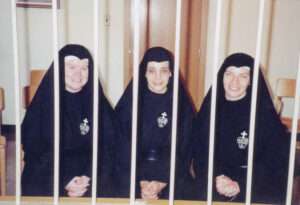
A related story: “The Habit of the Benedictines”
Faint voices floated from behind the faded drapes that separated the nuns’ portion of the parlor from their visitors’. On my side, an armchair was stationed in front of the curtains, like a theater set for an audience of one. I could only wonder what was waiting on the other side. And then, with a quick thrust, mother superior opened the curtains to reveal a steel grille. Behind the bars stood several women, swathed in black and looking like a row of Grim Reapers. Their eyes glowed like neon from shrouded faces, and from beneath the folds of their habits, pale arms reached through the bars to shake hands.
These were the strictly cloistered Passionist sisters and their garbs were, by far, the most dramatic I had seen on a year-long venture to convents and monasteries all across North America. Surprisingly, the habit has taken on a new popularity among younger nuns and a renewed disdain among an older generation of feminist sisters.
Conservative orders, like the Passionists, are among a growing minority of religious sisters in this country who believe that vowed religious women should retain the traditional outfit worn by nuns for centuries. Though the
Catholic Church requires sisters to wear a habit as a sign or symbol, most orders have discarded the Flying-Nun style gothic garb so familiar to the public. Traditional sisters see their modern counterparts as rebellious and defiant of the pope’s dictum. But to the majority of religious sisters in this country, today’s “habit” has been translated as simple clothing and an over-sized crucifix or a small pin that designates their particular order. These progressive sisters strongly feel that wearing the long, dark frock and veil are outdated medieval fashions that draw attention to the sisters and separate them from the people they are trying to serve.
Sisters vastly differ on a number of issues including the pope, sex and whether women should become priests. But in soul-baring interviews with more than 200 sisters from the strictest, most tradition-bound cloisters to the most radical nuns jailed for protesting, the issue that evoked the most intense emotions was the habit.
No one expects a nun to be a fashion plate. After all, nuns have given up husbands, children, sex and — stylish clothes. They take vows of poverty and spend their days in contemplation, chanting, praying or working with the poor. But in reality, what a nun wears is important. And in this country, the kind of clothes a religious sister wears determines what kind of nun she is or is perceived to be.
“Seeing the habit says you’re with the Holy Father (the pope) 100 percent,” explains Passionist Sister Marie Michelle Dziubela, 37. “Whereas a sister who isn’t wearing a habit, you have to wonder.”

Mother Mary Veronica Loring, 50, adds: “She’s making a statement, too — that she’s not wholeheartedly loyal to the Holy Father and to the teachings of the church.”
Passionist nuns live some of the most austere religious lives: They shave their heads; get up at 2 a.m. every day to pray; whip themselves with small leather lashes to share in the pain of Christ’s flogging; practice long-term fasting, give up foods such as fruit and vegetables during the summer as penance, and only speak one hour a day. Their suffering, they believe, can help save lost souls.
Although their faces seem pale and gaunt, their eyes tired with black circles, these women laugh and tell jokes and poke fun at slow-praying sisters or sisters who fall asleep during their vigils. Their favorite target, though, is sisters who don’t wear a habit.
“There was this nun,” starts Sister Marie Michelle in her Long Island accent, “who recently came out of the habit. She was wearing this short dress and she said to the priest, ‘I guess you didn’t know I had pretty red hair?’ And the priest responded, ‘No, sister I didn’t. I also didn’t know you had varicose veins,’” she said, yelping along with her sisters.
When these women searched out which order to join, they each wanted one in which they felt they could give their all or, as some say, “go all the way.” And part of that was that they wanted an order that required the full-length habit.
“I wanted something more austere, something more penitential, something more to sacrifice for Jesus,” explains Mother Mary Veronica, a former American Airlines stewardess who entered the Passionists 18 years ago. “I wanted it to hurt a little bit. I know that sounds masochistic, but that’s the only way to express how I felt.”
When Mother visited the Passionists for the first time in 1980 and saw their habit — a floor-length tunic with buttons from the neck to the waist, a long veil that covered the head and extended down to the thighs, an elongated strand of rosary beads attached to a hand-made leather belt and sandals — she was smitten. Her only turn-off, she concedes, was a black and white plastic pin the sisters wore over their hearts. “I thought it was very tacky.”

Some nuns say their first encounter with a habited nun inspired them to enter religious life. Sister Marie Michelle is tall with sparkling blue eyes. If she had hair, it would be thick and black. Even without makeup and after years of less than five hours of sleep a night, her face beams a wide smile. But she is quite serious when she says she made the decision to become a nun at the age of four.
The story goes that little Marie stood on a kneeler while her mother prayed beside her. In front of them sat a nun. “I leaned over the pew and I grabbed the bottom of her veil and I picked it up to see what was underneath it. And my mom grabbed my hand and was mortified and she said: ‘Don’t touch the nun! She’s married to Jesus.’ That was it for me.”
Appropriately, Sister Marie Michelle and the other sisters treat the habit with great reverence, kissing it before they put it on each day and praying litanies for each piece of the outfit. Though it may seem strange to us seculars that a dress — usually sewn by hand, and sometimes from an A-line Simplicity pattern — is regarded as sacred, these sisters believe the habit is a sign of their devotion to the Catholic Church and God. Envisioning themselves as the brides of Christ seems to justify their lives of hardship.
Now, Sister Marie Michelle takes the symbolism of marriage to Christ even further. If sisters are dragging to make the 2 a.m. prayer before the tabernacle — an ornate box in the chapel which holds the communion wafers they believe are the actual body of Christ — she tells them they have to hurry to see their husband. “Jesus is waiting for us,” she says. “He’s all alone down there and he wants us. He can’t wait until morning to see us.”
No one really knows exactly how the habit came to be. The first piece of clothing nuns wore in Europe was a veil in the third century, required of all married women. Since nuns were the brides of Christ, they were also expected to don a headpiece.
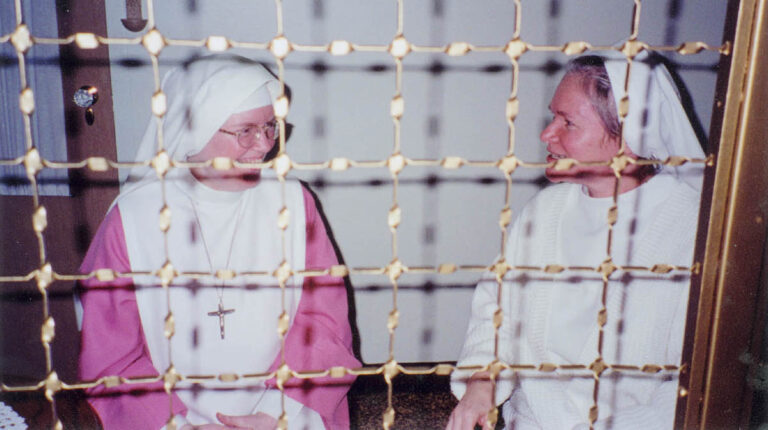
By the fifth century, monks and many nuns started wearing black: It was easier to keep clean and indicated both mourning and sobriety, explains medieval historian Jo Ann McNamara, who charts nuns through two millennia in her recent book “Sisters in Arms.” According to McNamara, nuns were the world’s first feminists and their outfits quite possibly were women’s first uniforms. In the early days, church bishops pressured nuns, many of whom came from nobility, to give up their fashionable clothes and adopt more humble attire. Eventually nuns became attached to their habits and refused to give them up even when it brought persecution.
In the twelfth century, nuns adopted the wimple, a tight headpiece that was a fashion in medieval Europe. But even after wimples became passé, nuns continued to wear them. Eventually, various orders developed distinct costumes: For example, Benedictines wore black and Franciscans wore brown.
During the French Revolution, nuns were seen by the revolutionaries as living frivolous and idle lives. Rebels took over convents and prohibited the sisters from wearing their habits — all in an attempt to abolish the aristocracy and the church’s clerics, many of whom were part of the upper classes and devoted to the monarchy. Those who continued to wear habits risked decapitation: condemned religious women often wore their habiliments to the guillotine as a final protest.
For decades, centuries, even, changes to the habit were relatively minimal. But in the 1960s, Vatican Council II — the three-year historic meetings of the church’s leaders from around the world — established new church rules in an attempt to modernize the Catholic Church and its religious orders. Nuns were told to update their habits and lifestyles. From the late 1960s until the early 1980s, nuns experimented with their dress and customs and the changes were usually ushered in by younger, more modern sisters.
On a humid August day, 400 people crammed into St. Mary’s Church in Alton, IL, near the banks of the Mississippi. As the organist played “Ave Maria,” sunlight filtered through the cathedral’s towering stained glass windows and lighted on the altar’s marble pink steps. In a few moments, 20-year-old Nicole Belongea and six other young women would stand here to pledge their lives to God by receiving what many consider a wedding dress: the nun’s habit.
This was the last day anyone would call Belongea by her given name. Once she donned the somber black dress and appeared before the gathering of friends and relatives, Archbishop Agostino Cacciavillan, the pope’s own U.S. ambassador, would anoint her Sister Mary Anselma. She had been waiting for this day since she was 16.
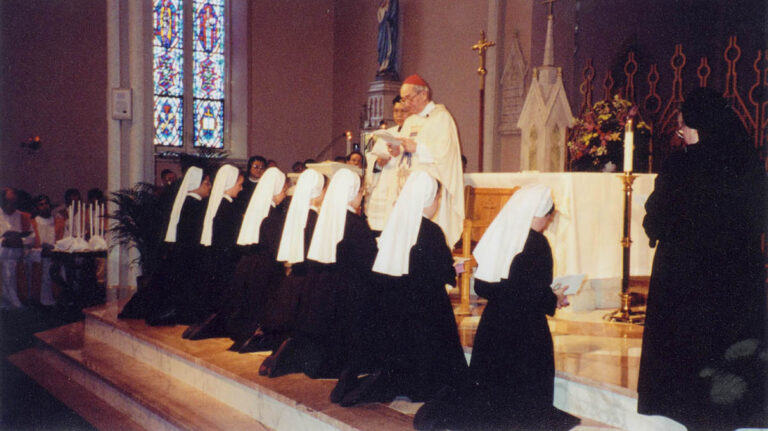
Belongea marched up the aisle carrying a tall white candle. A wide smile spread across her soap-cleaned face as she spotted her parents seated along with her brother and five sisters, their spouses and children. She wondered what her family thought of her hair. The sisters had shorn her brown tresses the day before, leaving strands less than a finger long. But Belongea kept back a long lock for her mother, a gift she would present no-doubt with tears. Belongea wasn’t nervous really, but excited, eager to get through the event. But what if she didn’t turn the right way or bow at the right time?
When the Archbishop called her to the altar, he placed the dress and veil in her hands and said: “The religious habit is the garment of your salvation.”
The postulants clutched their veils and habits to their chests and hurried to a back room where they slipped off their black jumpers and white blouses and put on their habits: calf-length, long-sleeved black dresses with pleats in the front and secret pockets in the petticoats where the sisters carry their rosaries, pens or candy. The young women stared at each other.
“You look so holy!” Belongea told one of the women, then giggled. Their veils felt awkward at first and they reminded each other not to get “veil neck” — a condition in which a sister stiffens and won’t turn her head for fear she’ll lose her veil.
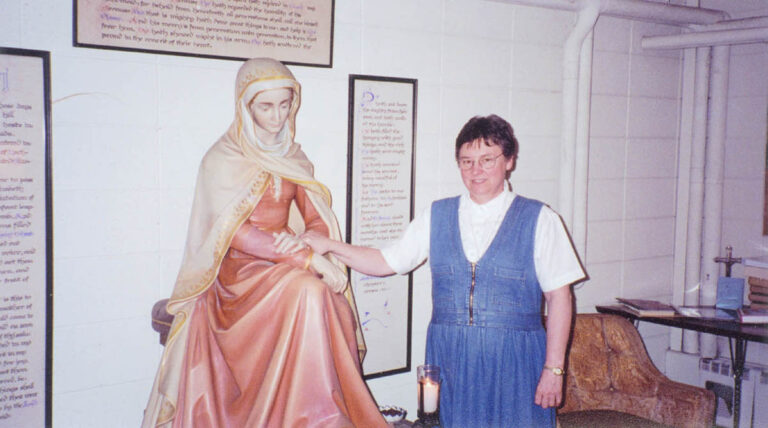
As the postulants reappeared in their new habits, the crowd craned their necks and murmured to each other. Several women in the audience wiped their eyes with wadded tissues.
Some wept openly. For the new Sister Mary Anselma, this ceremony was God’s way of clothing her and giving her a new identity.
After all these years of trying to get rid of the habit, few thought the antiquated outfit would actually attract women raised in a feminist era. But young nuns told me the habit is a real drawing card. Their statements seem to be backed by research at Georgetown University which shows that traditional religious orders in this country, who have retained the habit, are attracting on average 3-1 more women than progressive orders, most of whom do not wear the habit.
While it’s hard to say exactly why someone would chose one order over another, and religious women are not typically preoccupied by appearances, the habit is often part of the equation. For example, Sister Mary Anselma’s order in Alton has had more than 46 sisters enter in 10 years. Yet, another Franciscan order, just across the Mississippi in St. Louis, gave up the habit long ago and hasn’t had a single woman enter and stay in 15 years.
The habit has meant so much to some sisters they have changed convents and moved across the country in order to be with women who wore more traditional outfits. Sister Mary Regina, 51, a Redemptoristine, is in her second year as a sister. Sister’s graying black hair is teased into a bouffant over her forehead and covered by a white veil on the top and sides. She wears the red skirt and vest and white shirt of her order that is unique in the field of religious dress. The red symbolizes the love of Christ and the white symbolizes purity. Sister Regina transferred to her order in Lagoria, Mo., from another Redemptortistine monastery in New York because, she says, in Lagoria all the sisters wear habits and veils and at her old monastery some of them didn’t. “I wouldn’t want to be a nun if I couldn’t wear it,” she said. “It’s a sign of your consecration to God. You’re a visible sign if someone sees you.’”
But few people see cloistered sisters like Sister Mary Regina, who venture out of their enclosed monastery only when they have a doctor or dentist appointment. The sisters are even secluded in their chapel, which is open to the public. A sign outside the church warns visitors not to get too close: “We have an electric alarm system,” it reads. “If you pass beyond the communion rail, it will activate the alarm.”
For some women — even those in conservative, cloistered orders — the habit is disdained. Most nuns I spoke with felt that the fascination with habits was a young girl’s romantic fantasy. Feminist sisters are embarrassed and even angered that some sisters are so unenlightened that they still wear “the penguin suit.” Some call it the “holier than thou” dress. They believe the continued use of the habit in movies like “Sister Act” perpetuates the image of the nun as simple-minded, childlike and silly.
“For me, a twentieth-century woman going into the twenty-first century, the habit was an obstacle,” says Sister Eileen O’Donnell, 50. “It represented a lot of things that I didn’t care about in the church.” To Eileen, the habit, particularly the veil, connotes sexism.
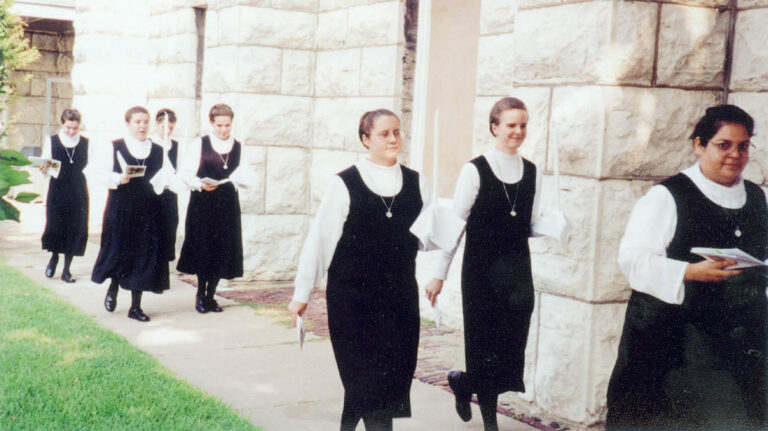
Recently, Sister Eileen entered the convent of the Holy Spirit Adoration Sisters in downtown Philadelphia. And though this former flight attendant, actress, Peace Corps worker and, most recently, urban hermit (a squatter who lives a life of prayer in abandoned houses) didn’t want to wear a habit, she picked an order known for its unique outfit. Called “the pink sisters,” the Adoration nuns wear floor-length, rose-colored habits with white veils that extend to their feet. Like the Passionists, they are cloistered and even in their ornate chapel, an imposing steel gate with massive locks separates them from the public. On the day I visited Sister Eileen and her Mother Superior talked to me through a grille. But it was only in a subsequent phone call that Sister Eileen allowed just how much she dislikes the habit.
“I don’t say anything because I know it’s such a hot topic,” she said, “so controversial that [my sisters] wouldn’t be open to hearing any reason why a person would not choose to wear the habit. The pope said to and that’s it.”
Sister Eileen’s skin is smooth and glowing, as if it had been doused with lotions and astringents for years. Her face is slightly tanned and wide with a chiseled jawline and teeth that look like they’ve never missed a dental appointment. Though her closets were once filled with fashionable clothes and visits to selective hair salons were routine, Sister Eileen says she has shed the vanity of her former life. Recently, she needed her hair cut. But instead of waiting two weeks for an appointment, she took out the scissors and indiscriminately chopped off her hair.
“I feel that God could care less what we wear,” she said.
Sister Eileen eventually came to terms with wearing the religious dress because as a cloistered nun, no one sees her. She has come to value the freedom of not having to worry about what to wear.
“I am really a product of the sixties,” she says. “I was part of all those revolutions and I would consider myself a feminist. I have long felt that the church is sexist and racist. So I just think that God has a good sense of humor to send me here.”
While Sister Eileen spent the sixties trying to change society outside the convent, Sister Patricia Ruether, now 54, tried to open the minds of her sisters inside the monastery. Entering in 1967, Sister Patricia was a 23-year-old postulant who at first thought wearing a habit was romantic. But wearing black day after day began to psychologically affect her, she said. The traditional habit was so hot it was damp when she took it off on summer nights and damp when she put it on again the next morning. She decided to accessorize.
So the next spring, when Sister Patricia graduated from St. Benedict’s College, she stepped lightly up the stage stairs to receive her college diploma, smiling to herself as she carefully lifted the hem of her somber black habit; beneath the hot folds of polyester, she wore a long, silky red slip.
“My novice director was just horrified,” Sister Patricia recalled. “She said, what if somebody sees it? And I thought, yeah what if someone sees it! For me it was important to know I was wearing something cheery, bright and special.”
When her order decided a year later to change the habit, Sister Patricia was among the first to discard hers.
While Sister Patricia welcomed the changes initiated by Rome, many older sisters were upset by what they saw as an attempt to secularize their sacred way of life. Sisters began moving into apartments and out from underneath the awesome control of Mother Superior. Changes in the habit at first amounted to raising hem lines a few inches, shortening the veil. The continual battle between the progressives who wanted to implement more changes and at a quicker pace and the traditionalists who desired to retain some of the traditions caused such a mass exodus that many orders have never recovered. In the last 30 years, the number of women in Catholic religious orders has decreased by 50 percent. Of the remaining 85,412 sisters in the United States, the average age is 68. Today the typical woman entering religious life is 39 years old, has a college degree and has worked several different jobs.
Anne Marie Gunderson, 51, a former college professor, is the mother of four and a recent grandmother. She is also a nun. Sister Anne Marie entered the Visitation Sisters Monastery in St. Paul, MN, in 1996. The Visitation Sisters wear blue denim skirts or jumpers with white shirts and palm-sized silver crosses that hang at breast-level. “St. James said to wear the dress of the times and I am a modern woman,” Sister Anne Marie explains. “I don’t need the habit to be a nun. I won’t hide behind that to be recognized as a sister.”
Some women say the habit presented such a barrier to their lifestyle that they rejected orders solely on the basis of what was worn. Dedra Serafin, 33, nearly joined one order that required the habit because her aunt and grade school teachers all belonged.
“So I was there, ready to become an affiliate,” remembers Serafin, now a Sister of Charity of Seton Hill in Greensburg, PA. “But they just put like this major, major emphasis on their habit. And because I was into athletics and all kinds of exercise and my field was going to be physical education, I just thought it was absolutely ridiculous that one would have to live, you know, in their habit and that one would have to, you know, perform your duties in a skirt and a veil!”
The women in Serafin’s order wear a gold medallion which reminds her of a wagon wheel. But when Serafin is teaching gym at her Catholic elementary school and wearing shorts and a T-shirt, she says it’s just not conducive to wear the gold pin. “People have a hard time understanding that, particularly older people,” she says. “They’re like: ‘How come you’re not in a habit? No one knows you’re a nun.’ But you know what? If they talk to me, hopefully they will see that there is something different about my life.”
A couple of months after her habit ceremony, I asked Sister Mary Anselma if she felt like a sister. She told me that sometimes she forgets, but then she looks down at her habit and it hits her that she’s really a nun.
Modern sisters scoff at their habited colleagues. But deep down I suspect they envy the attention the habit brings. Strangers approach habited nuns in airports or on the streets asking for their prayers or for a blessing. When a car full of habited sisters drives down the street, people stop and cross themselves. It seems unfair to modern sisters who only wear little pins, like they’re cheated in public respect by not drawing attention to who they are and what sacrifices they’ve made.
Sometimes it’s hard to comprehend that all these sisters take the same vows and for the most part give up the same things. Yet each side points to the other as though those women aren’t real nuns. It seems sacrilegious that women who have committed their lives to the ethereal world can still place so much emphasis on something so material. But the habit represents a profound intersection of faith and fashion.
Although impractical, some habits are stylish, maybe even glamorous with their long sweeping veils. What woman wouldn’t want to wear her wedding dress more than once? And let’s face it. If we gave up men, sex and money, we’d want to wear a special dress too.
©2000 Cheryl Reed
Cheryl Reed, a freelance writer in Minneapolis, is examining the changing role of the Catholic Church.

